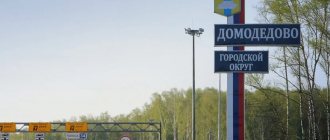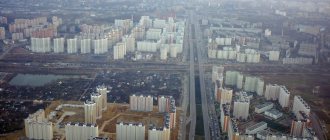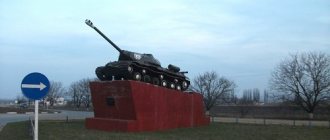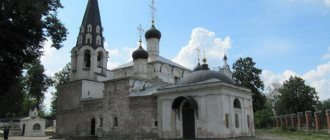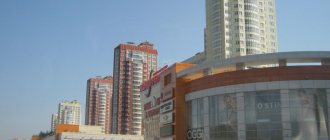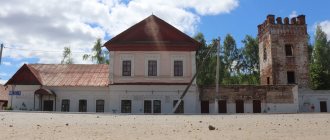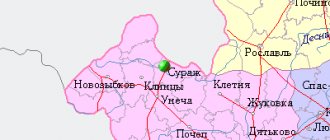| Dolgoprudny |
Dolgoprudny
, a city of regional subordination in Russia, makes up the city district of the same name in the Moscow region, the center of the Dolgoprudny deanery of the Sergiev Posad diocese. Located on the outskirts of the Meshchera Lowland, 20 km north of Moscow. Railway station on the Moscow-Dmitrov line. Population - 104,238 people (2017).
- On the map: Yandex.Map, Google map
The site where the city is now located is marked by two low mounds from the 12th century. Until a certain time, isolated villages and farmsteads were located here, and in the 14th century, manor houses with small settlements appeared. Since the second half of the 16th century, the village of Sterbeevo on the Gnilusha River
(later Gnilusha) has been known;
in 1617, the village of Kurlykovo on the Klyazma River
(later Kotovo) was first mentioned.
The center of the future city was the Vinogradovo estate on Dolgiye Prudy
, so named due to its location at the Dolgiye (“long”) pond, formed by a dammed river. In the 17th century, the estate was owned by G. G. Pushkin, then by his relatives, from 1729 by Prince V. V. Dolgorukov, from 1758 by A. I. Glebov, and from 1790 by E. I. Benkendorf. In 1905, the estate was burned by peasants and rebuilt again in 1911.
At the beginning of the century, a branch of the Moscow-Savelovo railway passed near the village of Vinogradova (Dolgikh Prudov) (now within the city of Kimry). In 1914, the Dolgoprudnaya
.
In 1931, construction of an airship shipyard, a gas plant and other structures for the operation of airships began next to the platform. At the same time, a workers' settlement with predominantly two-story buildings was built. On July 1, 1935, the village was officially classified as a workers' settlement and received the name Dirigiblestroy
. From 1932 to 1937, construction of the Moscow-Volga canal named after Stalin was carried out near the village. On July 15, 1937, the first permanent navigation along the canal opened, which became the western border of the village.
On October 19, 1937, due to the cessation of the construction of airships and the reorganization of production, the workers' settlement was renamed Dolgoprudny
. In 1940, the Central Aerological Observatory began working here. In 1953, the village became the center of the Krasno-Polyansky district.
In 1957, Dolgoprudny received the status of a city of regional subordination, after which housing and cultural construction began to pick up. In the 1950s-1960s it developed as a conglomerate of settlements attached to industrial enterprises and a physical and technical institute. In 1959, the village of Vodniki
, together with the Khlebnikov repair and maintenance base.
In 1963, Dolgoprudny was classified as a city of regional subordination, and the villages of Gnilushi
,
Kotovo
,
Shchapovo
and
Likhachevo
. Since the early 1970s, construction of nine- and sixteen-story buildings has been underway.
In 2003, the village of Khlebnikovo
, the village
of Paveltsevo
and the working village
of Sheremetyevsky
. In 2005, the urban district “Dolgoprudny City” was established, which included only the city itself. At the beginning of the 21st century, the Moscow Institute of Physics and Technology, the Dolgoprudny PATP State Unitary Enterprise State Unitary Enterprise Mostransavto, enterprises of the mechanical engineering, chemical, defense industries, as well as processing and construction enterprises were located in Dolgoprudny; There was a theater supplies factory.
Statistics
- 1939 - 8.0 thousand people
- 1959 - 33 thousand people
- 1970 - 53.1 thousand people
- 1989 - 70.8 thousand people
- 2005 - 77.1 thousand people
Will the city of Dolgoprudny become Moscow in the near future? The closest city to the capital!
Dolgoprudny is a town located in the Moscow region. It is located 18 km from Savyolovsky station. This is one of the closest cities of the capital, which is adjacent to the Moscow Ring Road on the north side. According to numerous estimates of modern experts, this town has simply wonderful prospects for subsequent successful and rapid development:
- Dolgoprudny is located in the top 10 closest cities to Moscow itself. For example, it is less than 5 km from the Moscow Ring Road.
- The town is located in the northern direction, where there is always a minimum number of new buildings. The demand for local real estate here is at a stable level.
- There is an excellent transport interchange. The local social infrastructure is also developed.
All the indicated factors are considered to be a kind of subsistence minimum for the emergence of the real popularity of this wonderful place, as well as for subsequent growth.
Dolgoprudny is characterized by the presence of the following features:
- Location from Moscow - less than 5 km.
- The population is 104 thousand people.
- Working population – 45 percent.
Dolgoprudny
The area where modern Dolgoprudny is located has been known for centuries. The fact that people once lived here is evidenced by mounds that supposedly appeared in the 12th century. There were many farms and settlements on this land. One of these villages, which emerged in 1931, became the city of Dolgoprudny. Starting from the 14th century, not only small poor villages consisting of just a few houses, but also huge noble estates appeared in these places. The Dolgoprudnaya railway platform appeared not far from the estate, built after the revolution. It was a state farm estate called “Long Ponds”. This name looks quite strange. But everything is explained easily and simply. The word "long" once meant "long". Not far from the platform, a station village arose, which in 1938 received its modern name in honor of the Dolgoprudnaya station.
Workers' village Dirizhablestroy
The development of the village was more than rapid. A year after the appearance of residential buildings, the first medical center was opened here. Over the next few years, other medical institutions appeared in the village: a dental office, a children's clinic, an x-ray room, and a pharmacy. In 1936, a hospital was built in the village, which marked the beginning of inpatient medical care in the village. In 1935, the settlement near the station received the status of a working village and was named Dirigiblestra. The workers' settlement had regional subordination. It belonged to the Communist region.
After the settlement receives a new status, the improvement of the Airship Construction begins. Multi-storey brick houses, sewerage, electricity and many other benefits of modern civilization appear in the village. At the end of the 30s, many cultural facilities were built. From the name of the settlement, it is easy to guess that the main activity of the local population was the construction of airships, which were in great demand in the 30s. Thanks to this type of production, a gas plant and water supply system appeared in the village. However, airships are gradually becoming obsolete and are being replaced by more modern technology. In 1938, the construction of airships stopped completely. The name of the village is also losing its relevance. In addition, it is quite inconvenient to pronounce and write. It was decided to rename the airship to Dolgoprudny.
Dolgoprudny
After the disappearance of the airship industry, the population of Dolgoprudny was forced to look for work. Fortunately, in 1937, 2 new enterprises arose near the village, the emergence of which was facilitated by the construction of the Moscow-Volga canal (today its name is the Moscow Canal). Not far from the canal, a granite factory arose, whose tasks included the production of facing material for locks, embankments and other canal structures. The second new enterprise is the Khlebnikovsky ship repair workshops, which arose on the site of the Khlebnikovo railway station. The modern name of the workshops is the Khlebnikovsky Machine-Repair Shipyard. These new enterprises not only provided income to the residents of Dolgoprudny, but also served as an impetus for the transformation of the workers' village into a city.
But the closest to Dolgoprudny was another enterprise - the Stone Processing Plant. This enterprise will play an important role in obtaining city status for Dolgoprudny. The plant began to build its own workers' village. The new settlement grew rapidly and gradually merged with Dolgoprudny. Today the village of Granitny (this is how the settlement next to the Stone Processing Plant was named) is the western part of the city of Dolgoprudny.
It should be noted that in the first years of its existence, the Stone Processing Plant experienced a number of difficulties inherent in all new enterprises. The building of the enterprise itself was made of wood, there was not enough equipment, and the workers were forced to live in poorly equipped barracks. But temporary inconveniences did not prevent the plant’s workers from fulfilling government orders for the cladding of Moscow metro stations and Soviet pavilions intended for exhibitions in New York and Paris. With the arrival of new specialists at the plant, the construction of additional workshops begins. These are no longer wooden, but brick buildings. A. Shemagin became the first director of the workshops. He was also the organizer of this enterprise.
In 1941, the plant workers who went to the front were replaced by their wives. The ship repair shops were evacuated to Perm, where they continued to work at the local ship repair plant, producing everything necessary for the front. In 1943, the workshops were transferred to the Moscow region. In record time, ship repair workers assembled the hull of the famous Moskovsky Komsomolets vessel. The ship took part in the battles of Leningrad and Stalingrad.
At the beginning of December 1941, the front line approached Dolgoprudny almost closely. The village was separated from the fighting by no more than 16 km. 13 residents of the working-class village of Dolgoprudny received the title of Hero of the Soviet Union for their participation in the Great Patriotic War. The leadership of school No. 3 created a memorial museum within the walls of its educational institution in honor of the military pilot, Hero of the Soviet Union N. Gastello.
In the post-war years, Dolgoprudny was faced with the task of developing as quickly as possible. In the late 40s, not far from the Dolgoprudnaya platform, construction began on a water supply station called Severnaya. Simultaneously with the construction of the station, the construction of comfortable cottages began. The new village was also named Severny. In 1953, the village of Dolgoprudny received the status of the administrative center of the Krasnopolyansky district. And in 1957, the village received the status of a city of regional subordination. Dolgoprudny becomes part of the Mytishchi district.
The status of a city obliged Dolgoprudny to high cultural development. In the early 60s, gasification of the new city began. In 1963, the rapid development of Dolgoprudny gave it the opportunity to become a city of regional subordination. The settlements closest to Dolgoprudny (the villages of Kotovo, Likhachevo, Shchapovo and Gnilushi, whose population has grown significantly) become part of the city.
In the 50s, the Moscow Institute of Physics and Technology opened in the city - the pride of Dolgoprudny. One of the initiators of the founding of the institute was Academician P. Kapitsa, who invested a lot of effort and time in the development and prosperity of the educational institution. It was this institute that became the alma mater for Nobel Prize winner Academician L. Landau. Today, Moscow Physics and Technology in Dolgoprudny is considered one of the best higher educational institutions in the country. Graduates of the institute have already distinguished themselves in many areas of modern Russian science.
The city reached its highest cultural and economic development in the 70s of the last century. In addition to highly developed industry, there were many cultural institutions here: 35 libraries, 3 cultural centers, 5 clubs, 2 music schools, the House of Pioneers, 6 public universities, a city park and a chess club. Despite the proximity of the city to Moscow, where there were even more similar institutions, the residents of Dolgoprudny tried to raise the cultural level in their city.
Thanks to the unusual combination of cultural and scientific institutions, today's Dolgoprudny is a combination of culture, science and production. Modern Dolgoprudny is a city with its own unique historical and cultural specifics. The economic, scientific and production potential of this city allows it to easily and confidently keep up with the times, while maintaining its uniqueness. Residents of Dolgoprudny love their city because it has everything necessary for a comfortable life: engineering and social infrastructure, quality housing, recreational areas, medical and educational institutions.
The city got its modern look in the 80s. The city administration continues to do everything possible to improve the quality of life of Dolgoprudny residents. The construction of new buildings, the demolition of dilapidated housing and the increase in the amount of living space per capita continues.
In 2003, Dolgoprudny expanded its borders. The city included the village of Paveltsevo and the working village of Sheremetyevsky, located not far from the city.
Will Dolgoprudny become part of Moscow?
Dolgoprudny is located at arm's length from the capital. It stretches along the railway line of the Savelovsky direction. There are as many as 5 platforms within the city. Thanks to this, the entire process associated with gaining access for residents to the capital is greatly facilitated. From the station you can get to Savelovsky Station in just 40 minutes. But from another station – 26 minutes is enough.
For bus passengers, as well as ordinary motorists, the situation is much more complex. You can leave the city using several highways. Although, if the city becomes part of the capital, everything should change to a large extent.
Regardless of everything else, it is worth noting that the highways above have recently been reconstructed. Although, nothing has changed much. There are constantly numerous traffic jams on highways.
Today, there is a project related to the construction of a light metro in this place. It will connect Moscow with such a wonderful city as Dolgoprudny. The project itself is quite large-scale. It has been discussed by the government for quite a long period of time. Although at the moment, no one has started to implement it. According to the authorities' plans, the entire construction process should be completed by 2025.
In any situation, many experts note the highest attractiveness of this town. Initially, all this is due to the close location to the capital itself. Depending on the microdistrict, the distance can be within 4-18 km. It is possible to get to any necessary place using a wide variety of modes of transport. We can talk about railway transport, a personal car, as well as public transport. There is also good access to major transport routes.
Many actions are being taken to relieve the local population from numerous traffic jams. It is guaranteed to ensure unhindered departure from the city, as well as arrival in the capital.
Religion
Until 2008, Dolgoprudny was part of the Dolgoprudny-Khimki deanery of the Moscow diocese. On December 5, 2008, a separate Dolgoprudny dean district was established with its center in the city.
From April 13, 2021, the city of Dolgoprudny belongs to the independent Sergiev Posad diocese within the Moscow Metropolis [1].
Temples
- "Recovery of the Lost", icons of the Mother of God
- St. George the Victorious
- Kazan Icon of the Mother of God
- Nicholas the Wonderworker
- Protection of the Blessed Virgin Mary
- in Dolgoprudny
- in Sheremetyevo
- in Kotovo-Spassky
- in Paveltsevo
What can you say about the local infrastructure?
The population is around 104 thousand people. Every year the number of residents increases by about 2 percent. Dolgoprudny is characterized by the presence of a fairly high indicator in such a direction as economic development. All this applies directly to the social infrastructure itself. One of the most famous technical universities is located almost in the central part of the city.
The number of retail spaces here is much smaller than in other similar areas. For example, for each individual resident there is approximately 80 square meters. m. If we talk about Moscow, then the average there is within 257 sq. m. m. Near Dolgoprudny there is a huge shopping center "RIO". This establishment is visited by a huge number of residents of this city.
The industry itself is well developed here. The highest level of providing citizens with much-needed jobs is constantly maintained. There is also a world-famous chemical plant here. It cannot do without a special stone processing plant. Approximately 45 percent of the local working population is employed in the city. You can always get a job at a ship repair yard.
What can you say about the ecological situation of this area?
The environmental situation in Dolgoprudny today is quite ambiguous. There is not only a chemical plant here, but also the Moscow Ring Road, as well as a solid waste landfill and an oil depot. In addition to all this, there is:
- A large number of parks.
- Forest areas.
- Local reservoir.
Most experts believe that the ecological situation of this area is considered one of the best in the entire Moscow region. Although, if we talk about the ranking of the cleanest cities, then Dolgoprudny was never in the top five. In any situation, there are fairly good averages here. Since the landfill closed, things have improved greatly.
Among the main environmental advantages, it is necessary to note the close location of the Long Ponds recreation area. It is located on the territory of one of the Moscow microdistricts. Although, the place is quiet and quite calm.
Will Dolgoprudny become part of Moscow? Nothing is known exactly about all this yet! Although, according to experts, such an action is indeed possible.
